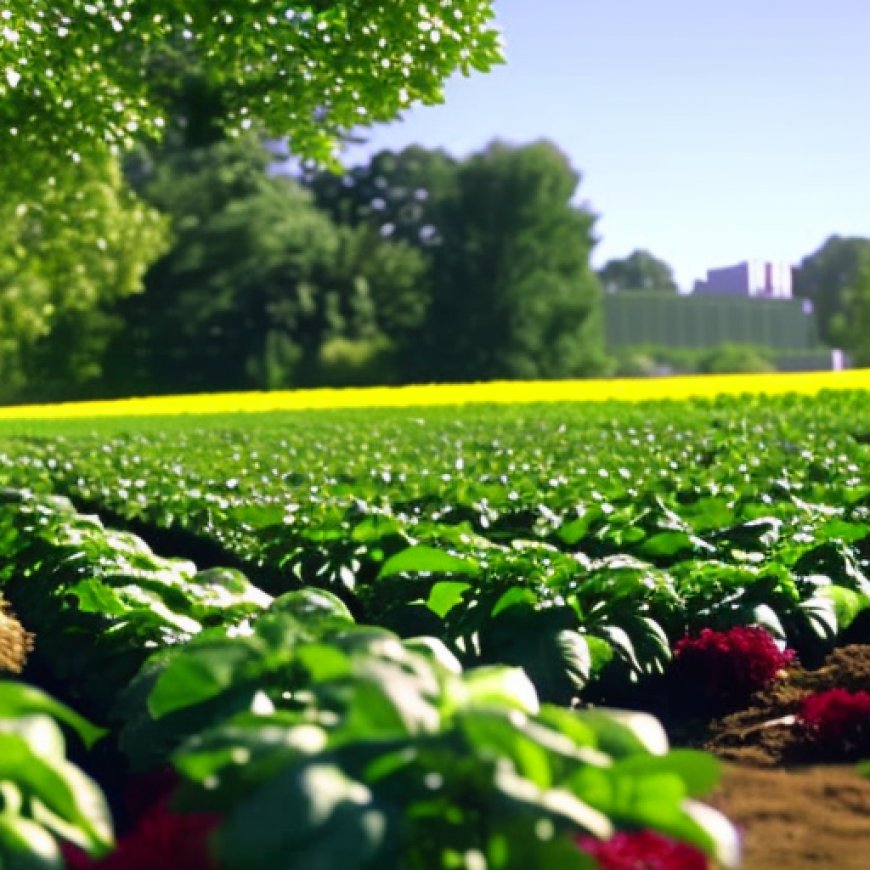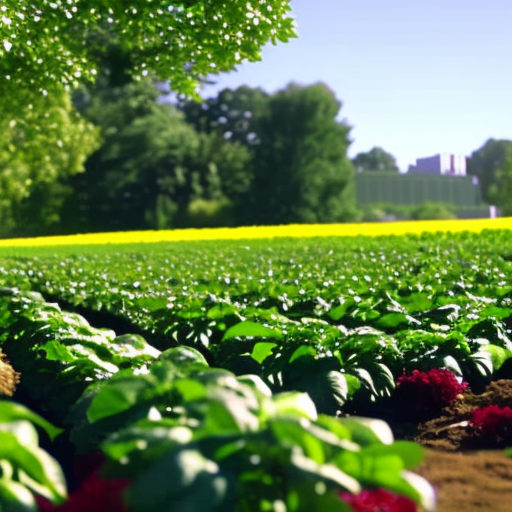USDA Invests $7.4 Million in 25 Urban Agriculture and Innovative Production Efforts
USDA Invests $7.4 Million in 25 Urban Agriculture and Innovative ... USDA.gov


USDA Invests $7.4 Million in Urban Agriculture and Innovative Production
WASHINGTON, July 18, 2023 – The U.S. Department of Agriculture (USDA) is investing $7.4 million in 25 selected grants that support urban agriculture and innovative production. Selected grant recipients, including community gardens and nonprofit farms, will increase food production and access in economically distressed communities, provide job training and education, and allow partners to develop business plans and zoning proposals. These grants build on $40 million in projects funded since 2020 and are part of USDA’s broad support for urban agriculture through its Office of Urban Agriculture and Innovative Production (OUAIP). Funding limits only allowed USDA to select the top scoring 10% of the applications reviewed. This year, USDA received more than 300 applications, which is twice last year’s applications.
Urban Agriculture and Innovative Production Grants
The Urban Agriculture and Innovative Production (UAIP) competitive grants program supports a wide range of activities through two types of grants, planning projects and implementation projects. Today’s announcement includes 25 selected planning and implementation projects.
Planning Projects
Planning projects initiate or expand efforts of urban and suburban farmers, gardeners, citizens, government officials, schools, and other stakeholders to target areas of food access, education, business and start-up costs for new farmers, urban forestry, and policies related to zoning and other urban production needs. Planning projects are expected to provide an early-stage investment in new and start-up projects with surveys, assessments, design and planning, business plan creation, feasibility studies, municipal policy, and zoning best practices.
Examples of planning projects include:
- Austin Youth and Community Farm Inc. in Texas, which will increase food equity in Travis County by using regenerative farming and natural resource conservation practices to double food production on two urban farms.
- Living Well Kent in Washington, which will transform the food production system to improve food security and advance equity among historically marginalized BIPOC, immigrant, and refugee producers and consumers.
Implementation Projects
Implementation projects accelerate urban, indoor, and other agricultural practices that serve multiple farmers and improve local food access. They may support infrastructure needs, emerging technologies, education, and urban farming policy implementation. Implementation projects are expected to expand the work on existing urban agriculture projects with on-the-job training, mentoring, business development assistance, school training in agricultural careers, and by expanding current operations of community gardens and nonprofit farms.
Examples of implementation projects include:
- Athens Land Trust of Georgia, which will provide locally grown food to the Athens community and offer workshops, paid employment for youth, and business opportunities for beginning and historically underserved farmers.
- Osage Nation in Oklahoma, which will install supplemental lighting for vegetable production facilities and systems along with installing a solar field and serve as a guide for Native nations looking to implement similar systems.
In total, 25 projects were selected in 16 states and territories. For a complete list of selected grant recipients and project summaries, visit Urban Agriculture and Innovative Production Grants | USDA.
USDA’s Support for Urban Agriculture
OUAIP, established through the 2018 Farm Bill, works in partnership with numerous USDA agencies that support urban agriculture and innovative production. OUAIP coordinates across USDA to help agencies identify, prioritize, and resolve internal barriers to service with urban, small-scale, and innovative customers. UAIP grants are part of a broad USDA investment in urban agriculture.
Other efforts include:
- USDA’s commitment to transforming America’s food system with a focus on local and regional food production, fairer markets, access to safe and nutritious food, and climate smart practices.
- USDA’s investments in infrastructure and clean energy capabilities throughout America.
- USDA’s commitment to equity by removing systemic barriers and building a more representative workforce.
To learn more about USDA’s initiatives, visit www.usda.gov.
#
USDA is an equal opportunity provider, employer, and lender.
SDGs, Targets, and Indicators in the Article
1. Which SDGs are addressed or connected to the issues highlighted in the article?
- SDG 1: No Poverty
- SDG 2: Zero Hunger
- SDG 8: Decent Work and Economic Growth
- SDG 11: Sustainable Cities and Communities
- SDG 12: Responsible Consumption and Production
- SDG 13: Climate Action
- SDG 15: Life on Land
The article discusses the USDA’s investment in urban agriculture and innovative production, which directly relates to addressing poverty (SDG 1) and hunger (SDG 2) by increasing food production and access in economically distressed communities. The grants also aim to provide job training and education, contributing to decent work and economic growth (SDG 8). The focus on urban agriculture aligns with the goal of sustainable cities and communities (SDG 11), while the emphasis on regenerative farming, natural resource conservation, and responsible production supports responsible consumption and production (SDG 12). The mention of installing a solar field and implementing climate-smart practices indicates a connection to climate action (SDG 13). Finally, the grants’ support for urban forestry and improving food security contributes to preserving life on land (SDG 15).
2. What specific targets under those SDGs can be identified based on the article’s content?
- Target 1.2: By 2030, reduce at least by half the proportion of men, women, and children of all ages living in poverty in all its dimensions according to national definitions.
- Target 2.3: By 2030, double the agricultural productivity and incomes of small-scale food producers, in particular women, indigenous peoples, family farmers, pastoralists, and fishers, including through secure and equal access to land, other productive resources and inputs, knowledge, financial services, markets, and opportunities for value addition and non-farm employment.
- Target 8.5: By 2030, achieve full and productive employment and decent work for all women and men, including for young people and persons with disabilities, and equal pay for work of equal value.
- Target 11.3: By 2030, enhance inclusive and sustainable urbanization and capacity for participatory, integrated, and sustainable human settlement planning and management in all countries.
- Target 12.2: By 2030, achieve the sustainable management and efficient use of natural resources.
- Target 13.2: Integrate climate change measures into national policies, strategies, and planning.
- Target 15.2: By 2020, promote the implementation of sustainable management of all types of forests, halt deforestation, restore degraded forests, and substantially increase afforestation and reforestation globally.
Based on the article’s content, the specific targets that can be identified include reducing poverty (Target 1.2), doubling agricultural productivity and incomes (Target 2.3), achieving full and productive employment (Target 8.5), enhancing sustainable urbanization (Target 11.3), achieving sustainable management of natural resources (Target 12.2), integrating climate change measures (Target 13.2), and promoting sustainable forest management (Target 15.2).
3. Are there any indicators mentioned or implied in the article that can be used to measure progress towards the identified targets?
Yes, there are indicators mentioned or implied in the article that can be used to measure progress towards the identified targets. These indicators include:
- Proportion of people living in poverty (Target 1.2)
- Agricultural productivity and incomes of small-scale food producers (Target 2.3)
- Employment rates and equal pay for work (Target 8.5)
- Improvements in urbanization and human settlement planning (Target 11.3)
- Sustainable management and efficient use of natural resources (Target 12.2)
- Integration of climate change measures into policies and planning (Target 13.2)
- Extent of sustainable forest management and restoration (Target 15.2)
These indicators can be used to track progress in reducing poverty, increasing agricultural productivity and incomes, achieving decent work, promoting sustainable urbanization, managing natural resources sustainably, integrating climate change measures, and implementing sustainable forest management.
Table: SDGs, Targets, and Indicators
| SDGs | Targets | Indicators |
|---|---|---|
| SDG 1: No Poverty | Target 1.2: By 2030, reduce at least by half the proportion of men, women, and children of all ages living in poverty in all its dimensions according to national definitions. | Proportion of people living in poverty |
| SDG 2: Zero Hunger | Target 2.3: By 2030, double the agricultural productivity and incomes of small-scale food producers, in particular women, indigenous peoples, family farmers, pastoralists, and fishers, including through secure and equal access to land, other productive resources and inputs, knowledge, financial services, markets, and opportunities for value addition and non-farm employment. | Agricultural productivity and incomes of small-scale food producers |
| SDG 8: Decent Work and Economic Growth | Target 8.5: By 2030, achieve full and productive employment and decent work for all women and men, including for young people and persons with disabilities, and equal pay for work of equal value. | Employment rates and equal pay for work |
| SDG 11: Sustainable Cities and Communities | Target 11.3: By 2030, enhance inclusive and sustainable urbanization and capacity for participatory, integrated, and sustainable human settlement planning and management in all countries. | Improvements in urbanization and human settlement planning |
| SDG 12: Responsible Consumption and Production | Target 12.2: By 2030, achieve the sustainable management and efficient use of natural resources.
Behold! This splendid article springs forth from the wellspring of knowledge, shaped by a wondrous proprietary AI technology that delved into a vast ocean of data, illuminating the path towards the Sustainable Development Goals. Remember that all rights are reserved by SDG Investors LLC, empowering us to champion progress together. Source: usda.gov
Join us, as fellow seekers of change, on a transformative journey at https://sdgtalks.ai/welcome, where you can become a member and actively contribute to shaping a brighter future.
|








